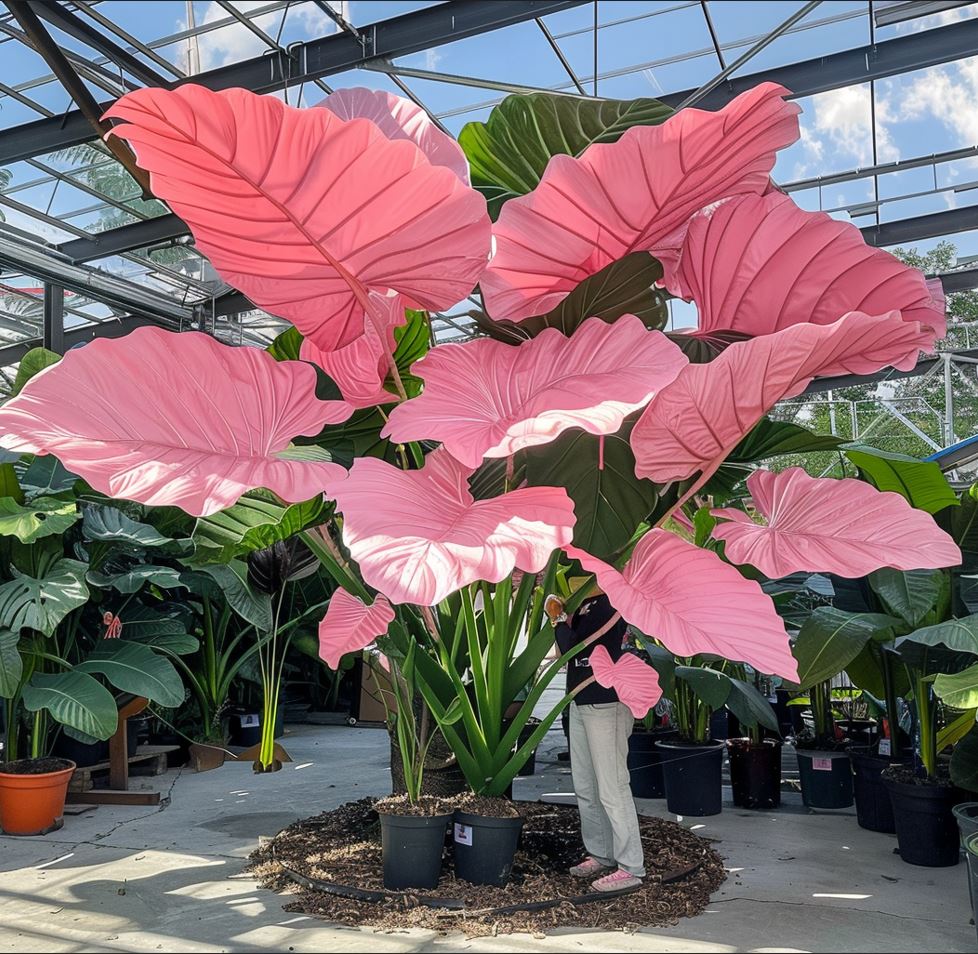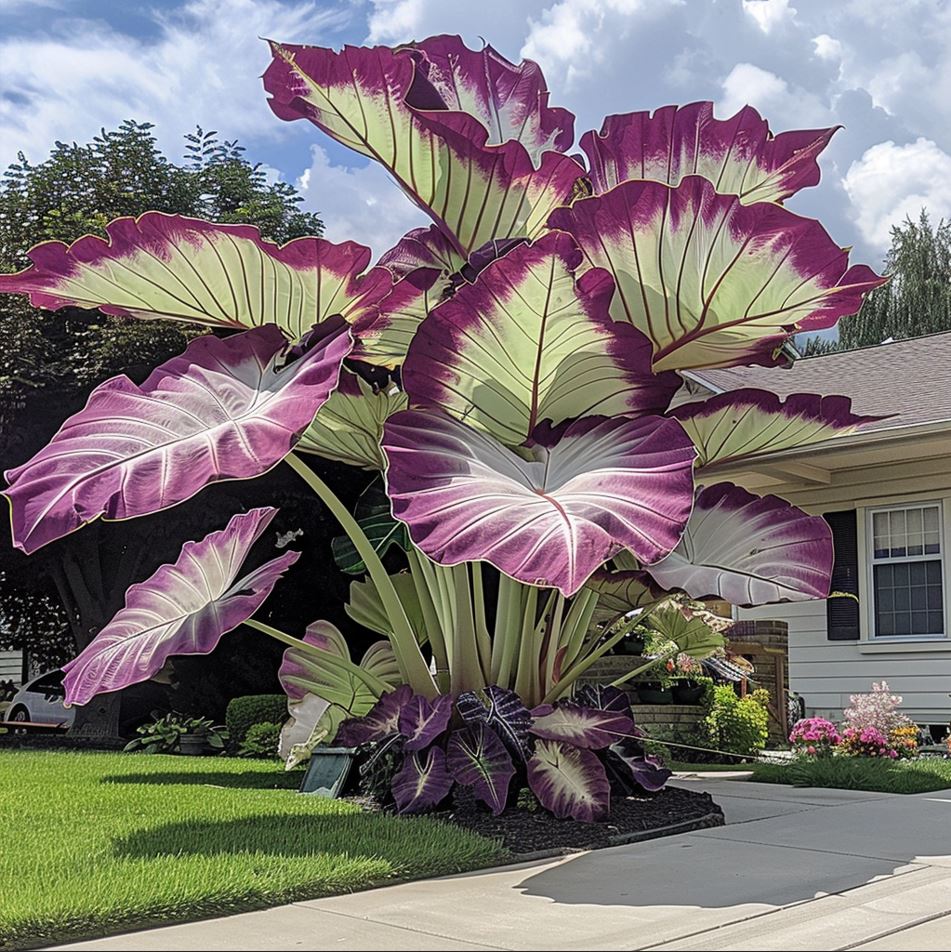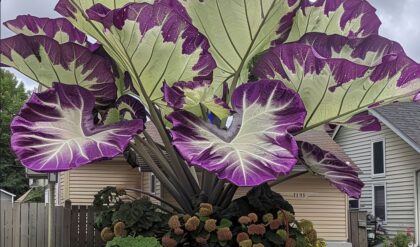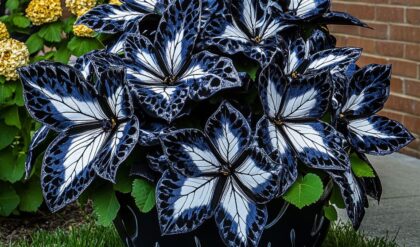Growing colocasia, commonly known as the elephant ear plant, can be a rewarding endeavor for both novice and experienced gardeners alike. With their strikingly large leaves and tropical appearance, these plants serve as eye-catching focal points in any garden or indoor space. However, cultivating them successfully requires an understanding of their specific needs and preferences.

Understanding the Basics of Colocasia
Soil Requirements
Colocasia thrives in rich, humusy, moist, and slightly acidic soil, ideally with a pH between 5.5 and 7.0. Imagine planting colocasia in a blend that resembles the forest floor—dark, earthy, and teeming with organic matter. You could even mix in compost or well-rotted manure to enhance its nutrient content.
The soil serves as a nurturing bed that provides not only structural support but also essential nutrients for the plant’s growth. It’s crucial to create a soil environment that mimics the natural habitat of colocasia, where it can thrive and flourish.
Light Preferences
When it comes to sunlight, colocasia prefers partial sun or filtered light. Morning sun is particularly beneficial, while strong afternoon sunlight can be overwhelming for the plant. Picture a scene where the elephant ears are basking in soft morning rays, absorbing just enough energy without being scorched. This delicate balance mimics the dappled light found in their natural habitat, creating ideal growing conditions.
It’s important to consider the amount of light your planting area receives and adjust the placement of colocasia accordingly. Striking the right balance between sun exposure and shade can make a significant difference in the plant’s health and appearance.
Watering and Humidity Needs
Watering is one of the most critical aspects of caring for colocasia. These plants enjoy consistently moist soil, often thriving in wet conditions without becoming waterlogged. A good practice is to monitor the moisture levels regularly and ensure that they do not dry out, especially during hot summer months.
Moreover, colocasia benefits from high humidity. If grown indoors, consider using a humidifier or placing a tray of water with pebbles near the plant to boost humidity levels. Visualize a miniature rainforest environment—a steaming sanctuary that keeps your colocasia flourishing.
Providing ample moisture and maintaining a humid atmosphere mimics the natural habitat of colocasia, ensuring its optimal growth and development.
Temperature Considerations
Temperature plays a pivotal role in the growth of colocasia. These plants prefer warmth and can suffer if exposed to temperatures below 50°F (10°C). If you’re looking to cultivate colocasia in cooler climates, bringing them indoors during frost spells may be necessary.

This adaptability highlights the resilience of colocasia, much like a phoenix rising from the ashes—finding ways to thrive even when faced with challenges. By understanding and catering to their temperature preferences, you can create an environment that allows colocasia to flourish, regardless of the climate.
Propagation and Planting
Propagating Colocasia
Colocasia can be propagated through various methods, including dividing the rhizomes, using offsets, or growing from seed. Each approach has its own advantages and considerations, allowing gardeners to choose the method that best suits their needs and preferences.
Dividing the rhizomes is a common and effective way to propagate colocasia. The rhizomes, which are the plant’s underground stems, can be carefully divided into sections, ensuring each section has at least one eye or growth point. This method allows you to create multiple new plants from a single established one, expanding your colocasia collection.

Offsets, or plantlets that form at the base of the parent plant, can also be used for propagation. Carefully removing and replanting these offsets can result in new, independent colocasia plants.
For those who prefer starting from seed, colocasia can be grown from seed, though this method may take longer to produce mature plants. The seeds should be planted in well-draining, nutrient-rich soil and kept consistently moist until germination occurs.
Planting Colocasia
When it comes to planting colocasia, timing and site selection are crucial. In temperate climates, the best time to plant colocasia is in the spring, once the threat of frost has passed. This allows the plants to establish their roots and foliage during the warm growing season.
Choose a planting site that offers the ideal growing conditions for colocasia. As mentioned earlier, these plants thrive in partial sun or filtered light, with consistently moist and nutrient-rich soil. Consider the mature size of the colocasia variety you’re growing and ensure the planting area has enough space to accommodate its expansive growth.
When planting, dig a hole that is slightly larger than the root ball or rhizome, and plant the colocasia at the same depth it was growing in its previous container or location. Gently firm the soil around the plant, and water thoroughly to settle the roots.
Remember to provide support or staking if needed, as the large leaves of colocasia can be susceptible to damage from wind or heavy rain.
Ongoing Care and Maintenance
Watering and Mulching
Maintaining consistent soil moisture is crucial for the health and growth of colocasia. These plants thrive in consistently moist, but not waterlogged, conditions. Regularly check the soil and water when the top inch or two becomes dry.
During hot, dry periods, you may need to water more frequently to ensure the soil remains evenly moist. Avoid letting the soil dry out completely, as this can stress the plant and lead to wilting or leaf damage.
Mulching around the base of the plant can help retain soil moisture and suppress weed growth. Use a 2-4 inch layer of organic material, such as shredded bark, wood chips, or leaf litter. This mulch layer will also help insulate the roots and provide additional nutrients as it decomposes.
Fertilization
Colocasia benefits from regular fertilization during the growing season to encourage lush foliage and robust growth. Look for a balanced, water-soluble fertilizer or one that is high in potassium to support leaf development.
Apply the fertilizer according to the manufacturer’s instructions, typically every 4-6 weeks during the growing season. Be cautious not to over-fertilize, as this can lead to excessive leaf growth at the expense of the plant’s overall health.
Alternatively, you can incorporate slow-release or organic fertilizers, such as compost or well-rotted manure, into the soil when planting or refreshing the soil around the plant. These nutrient-rich amendments will provide a steady supply of nutrients throughout the growing season.
Pest and Disease Management
Colocasia, like many plants, can be susceptible to various pests and diseases. Common issues include spider mites, aphids, and fungal infections. Regularly inspecting your plants and addressing any problems promptly can help prevent serious infestations or infections.
If you notice signs of pests, such as webbing, discolored leaves, or insect presence, a gentle wash with soapy water or the application of neem oil or insecticidal soap can often remedy minor infestations. Regularly monitoring and addressing any pest issues can help keep your colocasia healthy and thriving.
In terms of disease management, providing adequate air circulation, avoiding overhead watering, and ensuring proper soil drainage can help prevent fungal infections. If you suspect a disease, consult with a local garden center or extension service for specific treatment recommendations.
Overwintering and Cold Protection
Colocasia’s sensitivity to cold temperatures makes overwintering a crucial consideration, especially for gardeners in colder climates. In regions where the ground freezes during the winter, the plants will need to be dug up and stored indoors.
Before the first frost, carefully dig up the rhizomes, leaving as much soil attached as possible. Gently clean the rhizomes and allow them to dry in a shaded, well-ventilated area for a few days. Once dry, the rhizomes can be stored in a cool, dark place, such as a basement or garage, where temperatures remain above freezing.
During the storage period, check the rhizomes periodically and mist them lightly to maintain some moisture. In the spring, when the threat of frost has passed, the rhizomes can be divided and replanted in the garden.
For colocasia grown in containers, the entire pot can be brought indoors and placed in a cool, well-lit location during the winter months. Ensure the soil remains slightly moist but not waterlogged, and provide supplemental lighting if the plant does not receive adequate natural light.
Varietal Exploration
The colocasia genus encompasses a wide range of cultivars, each with its own unique characteristics and visual appeal. Exploring different varieties can add diversity and interest to your garden or indoor display.
Some popular colocasia cultivars include:
- ‘Illustris’: Featuring dark green leaves with a purple-black undertone, this variety offers a striking and dramatic appearance.
- ‘Fontanesii’: Also known as the “black magic” colocasia, this cultivar boasts deep purple-black foliage that creates a bold contrast in the garden.
- ‘Esculenta’: The classic colocasia, or “taro,” with its iconic large, heart-shaped leaves and tropical aesthetic.
- ‘Mojito’: A more compact variety with yellow-green leaves and purple-tinged stems, adding a vibrant touch to smaller spaces.
- ‘Puckered Up’: Showcasing a ruffled, textured leaf surface that adds visual interest and depth to the plant’s appearance.
Each variety of colocasia brings its own distinct charm, allowing gardeners to experiment and curate a collection that reflects their personal style and preferences.
Conclusion
Growing colocasia (elephant ear plant) is more than just a gardening task; it’s about creating a vibrant ecosystem that mirrors nature’s beauty and complexity. By providing the right conditions and care, you’ll foster an environment where colocasia can thrive, transforming your space into a verdant retreat reminiscent of tropical landscapes.
From understanding the specific soil, light, and water requirements to exploring the diverse range of cultivars, the journey of cultivating colocasia is a rewarding one. With the right knowledge and a touch of creativity, gardeners can unlock the true potential of these majestic plants, bringing a touch of the tropics to their own backyard or indoor oasis.



